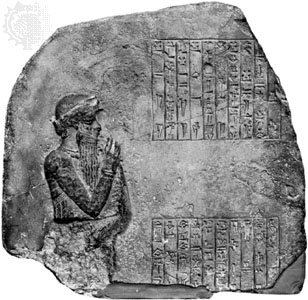Who would become the first king of the Babylonian Empire as well as gain fame for his creation of a law code? From conqueror to administrator, Hammurabi ruled over the Babylonian Empire during the years from 1792 to 1750 B.C.E.1 Hammurabi improved upon the techniques that the Akkadian ruler Sargon I had used previously to govern, which included bureaucratic rule and regular taxation.2 The most influential contribution on behalf of Hammurabi was his code of law. Although Hammurabi introduced the code towards the end of his reign, it was nonetheless influential.
Mesopotamian Law at that time was the most extensive form of law to have existed.3 The code helped Hammurabi establish order between all the diverse groups of people under his control. After conquering various groups of people, Hammurabi needed to bind these different groups together.4 Hammurabi gathered his people at the city of Babylon and unveiled a stele (stone slab).5 Hammurabi claimed to have come upon the laws through the god of Babylonian justice, Shamash. It was Hammurabi’s belief that the god had chosen him to deliver the laws to his people.6 The stele contained 282 laws to govern the people of his empire.7
Furthermore, the laws dealt with a variety of aspects of human life within the empire. The code illustrated major and minor offenses as well as their punishments. More often than not, the punishments were either death or a monetary fine. The code was written in cuneiform (a writing form adopted from the Sumerians), but the laws were carved in the Akkadian language. An example of the kinds of laws the Code contains can be seen in its first statute: “If a seignior accused a[nother] seignior and brought a charge of murder against him, but has not proved it, his accuser shall be put to death.”8 A monetary example is rule number two-hundred twenty: “If [a physician] opened his eye-socket with a bronze lancet and has destroyed his eye, he shall pay one-half his value in silver.”9
It is important to note that the Hammurabi Code made a strong distinction between social classes. For example, in sections 196 to 199 the Code reveals the application of the legal principle lex talionis (Latin for law of retribution). When a seignior (free man) commits a wrong to another seignior, the penalty was that the same infraction would be administered upon the perpetrator.10 However, if a seignior committed that same wrong to someone of a lower social class, the accused seignior did not have the same wrong attributed back. However, if a poor man is wronged, then one can simple pay a fee. Evidence for the social distinction is illustrated well with rules 196 and 198. Rule 196 states, “If a seignior has destroyed the eye of a member of aristocracy, they shall destroy his eye.”11 However, on the other hand, rule 198 states, “If [a seignior] has destroyed the eye of a commoner or broken the bone of a commoner, he shall pay one mina of silver.”12 It is believed that the typical phrase “an eye for an eye” became the core principle for Hammurabi’s Code. The slaves were even below the other two classes as evidenced with rule 199, which states, “If [a seignior] has destroyed the eye of a seignior’s slave or broken the bone of a seignior’s slave, he shall pay one half his value.”13

The stele containing the law code was displayed out in the public. The purpose was so that everyone could see the law. However, there was a slight issue: most people at that time were not literate. Therefore, although the law was displayed, very few were actually able to read and comprehend it. The rich and elite were favored while the poor and women were not treated equally. As a result, the Code became a reflection of the distinctions between the social classes, and between gender roles as well.
Hammurabi’s code would appear to be quite controversial and simplistic in the view of modern society. However, the code proved to be effective throughout Hammurabi’s reign. A point of controversy that arises from Hammurabi’s Code is the wording within the code. As opposed to modern law’s use of statements such as “this is not allowed” or “it is illegal to…” Hammurabi’s Code pursued more of “action X results in consequence Y.”14 An example to illustrate such process is as follows: if someone steals something (action X) the result is the death of the accused (consequence Y).
Although society has now progressed beyond the time of Hammurabi in several aspects of human society such as in law, it is important to analyze the roots of those developments. Furthermore, there also lies importance in drawing similarities between the past and modern society. How does modern society differ from Hammurabi’s in terms of social status and laws? Does modern law treat everyone equally in society? If not, then what similarities does modern society share with Hammurabi’s time? Human society is able to gain insight into the origins of contemporary social, political, economic and cultural problems.
- Ronald Wallenfels, ed., “Hammurabi,” in World Eras, vol. 8, Ancient Mesopotamia, 3300-331 B.C.E. (Detroit: Gale, 2005), 283. ↵
- Jerry H. Bentley, Herbert F. Ziegler, and Heather E. Streets-Salter, Traditions & Encounters: A Brief Global History, Fourth, vol. 1 (New York, NY: McGraw-Hill Education, 2016), 10–12. ↵
- Don Nardo and Robert B. Kebric, eds., “Hammurabi (Reigned Ca. 1792–1750 B.C.),” in The Greenhaven Encyclopedia of Ancient Mesopotamia (Detroit: Greenhaven Press, 2007), 134–35. ↵
- Brian Bonhomme and Cathleen Boivin, eds., “Code of Hammurabi,” in Milestone Documents in World History: Exploring the Primary Sources That Shaped the World, vol. 1, 2350 BCE – 1058 CE (Dallas, TX: Schlager Group, 2010), 16. ↵
- Jennifer Stock, ed., “Hammurabi Establishes a Legal Code,” in Global Events: Milestone Events Throughout History, vol. 5, Middle East (Farmington Hills, MI: Gale, 2014), 38–40. ↵
- Jennifer Stock, ed., “Hammurabi Establishes a Legal Code,” in Global Events: Milestone Events Throughout History, vol. 5, Middle East (Farmington Hills, MI: Gale, 2014), 38–40. ↵
- James B. Pritchard, ed., Ancient Near Eastern Texts Relating to the Old Testament, Third Edition (Princeton, NJ: Princeton University Press, 1969) 177. ↵
- Pritchard, ed., Ancient Near Eastern Texts, 166. ↵
- Pritchard, ed., Ancient Near Eastern Texts, 175. ↵
- Alfred J. Andrea and Carolyn Neel, eds., “Hammurabi’s Law Code and the Tripartite Structure of Mesopotamian Civilization,” in World History Encyclopedia, vol. 3, Era 2: Early Civilizations, 4000-1000 BCE (Santa Barbara, CA: ABC-CLIO, 2011), 150–51. ↵
- Pritchard, ed., Ancient Near Eastern Texts, 175. ↵
- Pritchard, ed., Ancient Near Eastern Texts, 175. ↵
- Pritchard, ed., Ancient Near Eastern Texts, 175. ↵
- Bonhomme and Boivin, eds., “Code of Hammurabi,” in Milestone Documents in World History: Exploring the Primary Sources That Shaped the World, vol. 1, 2350 BCE – 1058 CE, 18. ↵



33 comments
Morghan Armenta
Despite Hammurabi’s intentions of making his kingdom a better place through the enforcement of the law, I’d have to agree that he majorly reinforced and ingrained unfair distinctions in social classes and gender through his code. Although it may have served as a form of organization for a first major city in our history, even so, we can blame this code for perpetuating an unhealthy outlook on women and the lower class citizens. Great article, I enjoyed this read.
Richard Navarro
Its interesting to see how much humans have changed, yet how little they have changed. Hammurabi lived so long ago yet still display so many customs and courtesies that many people have today. Of course, the code is very different as it is today, but it still is along the basis of our system as well. I wonder if he influenced the way laws are now, or is it that just all humans share some distinctive traits such as enforcing the laws of the code?
Eduardo Foster
Really great article! It’s interesting that from the Hammurabi’s code there are differences between social classes and inequalities. When people say that under law they are “equal” it is actually in my opinion a lie. People still now in days are not equal under the law. I agree society have made improvements with the years but still is not an equal society in my opinion. Really enjoy the article!
Steven Clinton
Interesting article, Hammurabi code provided a quality precursor to modern day law. It’s interesting to learn how most people of that time couldn’t even read the code because of illiteracy. This shows that even back then inequality was still prevalent. I wonder how Hammurabi decided to create these specific laws in whole. Overall this is an excellent article that provides detailed information.
Nicolas McKay
This was such an interesting article George! Now I finally understand where “an eye for an eye” came from. When I read ow they were laws written on stone tablets, my mind immediately thought of the ten commandments Moses brought down in the bible. I wonder which came first, and if one drew inspiration from the other.It is also interesting how heavily the code differentiated the several different social classes, and it is sad that some classes were given more freedoms than others. Nevertheless Hamurabi was certainly wise when he developed these, as hey succeeded in laying laws for many different people for so long of a time. well done again.
Samuel Sanchez
Insightful article. I knew some information about the laws but i did not know there was 282 of them. I honestly only knew an eye for an eye law. I did not know the stone where the laws were on was called a stele and it was Hammurabi’s duty by god to deliver these laws to his people. These laws were crafted well in order to keep a balance society and it did work well. I liked how you explained the differences in the laws and how they affected certain classes. Great job keep up the good work.
Aaron Mcglown
I like how you stated that there was like 282 laws because i thought Hammurabi only had the one law and that was an eye for an eye. This was a very good article, it gave a good look in the way the society was back then. it makes me think, what if the Hammurabi code was still used today. How would society be?
Jennifer Pogue
Very fascinating article. The Haummabri’s code of law seems so outrageous, but it did help advance cuneiform into the start of an alphabet, so we do owe them that. I cannot imagine such an unfair “justice” system. I had always thought the phrase an eye for an eye was a modern phrase, I had no idea its origins were from thousands of years ago! I am very thankful that these ancient laws are not used in the United States.
Irene Astran
Thank you for pointing out the differences in the codes of law. I could see where some would argue that Hammurabi’s code of law is more straightforward. It blatantly states the consequences of your crime, but I think that even the most wise being of that time could not foresee all types of crimes that were to come about. Our very own U.S. Constitution has many gray areas as well. Our founding fathers could not determine all of the issues the country would run into and because of this there are many open ended statements made in the document. Hammurabi’s code had straightforward statements whereas the U.S. Constitution formed their statements so that they could be dynamic. Which way governs a society better?
Tina Valdez
It’s difficult to imagine such an extensive law, however it is also difficult to imagine that establishing order between diverse groups would take a non-extensive law. I wonder what a version of Hammurabi’s code would look like today. In your article you mention that it would be controversial in modern society, but I wonder what major issues it would shed light upon. I like the questions that you raised at the end as well, certainly left me with a great deal to ponder over. Great job!